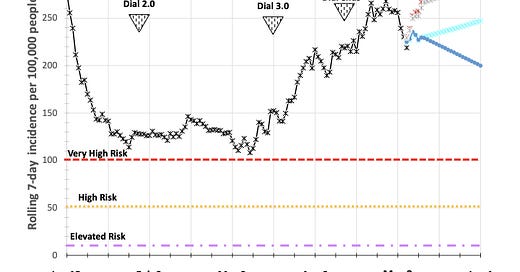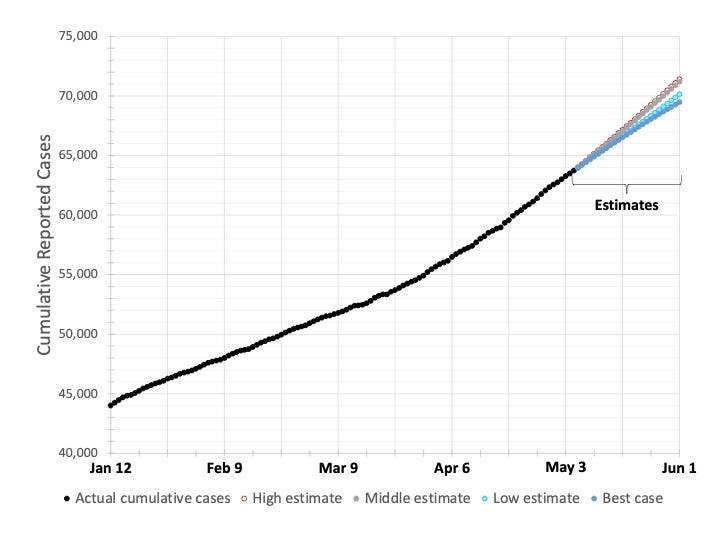COVID-19 Forecast for El Paso County — May 10
Plus, our resident microbiologist on how viral evolution affects young people
Good morning, and happy Monday. On this pandemic date last year, Llamapalooza had been cancelled after all on-campus events during Block 7 and 8 were canceled in March 2020. (This year, Llamapalooza is taking place in virtual and in-person formats over the course of three weekends, with the second weekend finishing up on Saturday.)
Today, Phoebe Lostroh returns to give her weekly COVID-19 forecast for El Paso County and to explain the current state of viral spread in Colorado Springs. Lostroh is a professor of molecular biology at Colorado College on scholarly leave who is serving as the program director in Genetic Mechanisms, Molecular and Cellular Biosciences at the National Science Foundation.
➡️ICYMI: On Wednesday, we explained what study abroad programming may look like next year. Also, how the pandemic has impacted class times.
📃TAKE THIS SURVEY: We have put together a survey for CC students to gather data on what they think about their own and others’ behaviors throughout this pandemic school year.
Phoebe’s Forecasts
NOTES: These forecasts represent her own opinion and not necessarily those of the National Science Foundation or Colorado College. She used the public El Paso County dashboard for all data. Lostroh prepared these forecasts on May 8.
⚖️ How her predictions last week shaped up: May 8 is the last day of Morbidity and Mortality Weekly Report week 18 in the national public health calendar. It is the 61st week since the first case was detected in El Paso County. Since March 13, 797 El Paso County residents have died of COVID-19. Last week, Lostroh predicted between 1,854 and 1,989 new cases in El Paso County for the week ending May 6. There were actually 1,667 cases.
Cumulative reported cases in El Paso County with predictions
🗝️ Key points: Reported cases are in black circles while the red, grey, light blue, and dark blue symbols provide estimates based on curve-fitting for the most recent 21, 14, and seven days. For the week ending May 13, Lostroh predicts 1,635-1,823 new cases in El Paso County.
“The trajectory of predicted cases is less certain because newly-reported case counts are more erratic from day-to-day compared with previous waves of infection,” Lostroh said.
Rolling seven-day cumulative incidence in El Paso County with predictions
🗝️ Key points: The actual calculated incidence is in black Xs, while the red, gray, light blue, and dark blue symbols provide estimates based on curve-fitting for the most recent 21, 14, and seven days. The purple, orange, yellow, and blue lines at the top of the graph show when El Paso County had orange and yellow safety precautions in effect, and when the 5 Star State Certification Program and state mask mandate went into effect. The purple, yellow, and red-dotted lines show the Centers for Disease Control and Prevention’s thresholds for risk categories. As of May 9, the incidence per 100,000 people in El Paso County over the last seven days was 227.
“Newly-reported cases have declined for the past four to five days, yet over-all the load of active cases is very high, more than twice the CDC threshold for very high risk,” Lostroh said. “Variant SARS-CoV-2 viruses with more dangerous properties have been detected all over Colorado for about two months.”
Seven-day rolling percent positivity compared with daily percent positivity in El Paso County
🗝️ Key points: The seven-day rolling percent positivity for nasopharyngeal tests for viral nucleic acids is plotted in dark blue diamonds, while the daily percent positivity is plotted in open light blue diamonds. The purple, yellow, and red-dotted lines show the thresholds for the CDC’s risk categories. As of May 9, the percent positivity in El Paso County was around 8%.
“The percent positivity is near the 8% ‘high’ CDC threshold, indicating that the county is undercounting total cases,” Lostroh said.
New COVID-19 hospitalizations compared with the regional census of hospitalized COVID-19 patients
🗝️ Key points: Daily hospitalizations are plotted in blue using the left-hand axis, while the census of regional hospitalized COVID-19 patients is plotted in red on the right-hand axis. As of May 9, the seven-day average daily hospital admissions in El Paso County was at 6.
COVID-19 vaccinations in El Paso County
🗝️ Key points: The El Paso County vaccine dashboard tracks county vaccine distribution. The number of people who have been partially or fully vaccinated in El Paso County is indicated with purple symbols. El Paso County has administered a total of 447,721 doses. Some of those doses were the first shot someone received, while others were the second shot to complete the vaccine series. As of May 9, 203,127 people have received both shots and thus have completed the immunization series.
“Immunization of children and teens ages 12-15 is expected to start soon, which may change the rate of immunization,” Lostroh said. “The US expects an emergency use authorization to give the Pfizer vaccine to children 12 and up starting in the next week or two.”
Q-and-A with Lostroh: Our resident microbiologist on the B.1.617 variant
This interview has been edited for length and clarity.
CC COVID-19 Reporting Project: The B.1.617 variant, a variant of interest first identified in India, has been found in Mesa County, Colo. What is a variant of interest, and to what extent will the emergence of another variant in Colorado impact transmission in the state?
Lostroh: A variant of interest is one that might have worse properties, but we haven’t studied it enough to know yet whether it does really have worse properties, whereas a variant of concern definitely has at least one property that’s worse than the other, such as being more transmissible or more deadly or more resistant to treatments. People are concerned about it because it has multiple mutations, two of which change the surface of the spike protein that we know is needed to interact with antibodies and/or the receptor. So the question is whether it will have a new way of interacting with the receptor that makes it more efficient at entering, or whether the binding of antibodies at that site will be less good, especially antibodies from people who were infected with the ancestral strain or people who got vaccinated. Often with the AstraZeneca or the Johnson & Johnson vaccines — not necessarily the Moderna and Pfizer, they’ve been pretty robust — it’s possible that antibodies raised against the ancestral strain won’t be able to neutralize the India variant as efficiently, which would mean you would need more antibodies in your blood to control the infection.
CCRP: According to ABC News, people under 20 are making up a larger portion of new cases in Colorado as well as across the country. To what extent does this concern you, and what does this mean for viral spread in the state?
Lostroh: I was just listening to “This Week in Virology,” and they were doing their monthly clinical update with Dr. Daniel Griffin, a virologist in New York, who talked about the most recent clinical care issues, and they are seeing a huge increase in the number of children with a variety of inflammation and clotting problems in the hospital because of COVID-19. We saw this a little bit earlier in the pandemic, but now it’s happening more frequently to kids and there still is no emergency use authorization for those ages 12-16, so we all are hoping that in the next week or two there will be emergency use authorization for ages 12 and up for the Pfizer vaccine. When that happens, I would expect that at least some people are going to be really eager to vaccinate their teenagers, so that’ll really help. But for families who don’t choose to vaccinate, or for children under 12, the best way to protect them is for us to get to herd immunity. So we need to get everyone vaccinated to protect those 11-year-olds who can’t yet have the vaccine. It concerns me, this is exactly the situation I wanted to avoid by controlling replication and therefore controlling evolution. Now, I know of no factual evidence of a virus evolving to infect younger people better than it infects older people, but I can’t think of any reason why, a priori, it would not be possible for this virus to adapt itself to infecting younger people rather than older people. Clearly it can infect younger people, or we wouldn’t see the infections that we see. So again, we just really need to limit the replication so that it stops evolving and because it is concerning to me that it could adapt to infecting younger people. We’re kind of doing the perfect experiment to find out if variants can adapt to younger people, which is very bad. We vaccinated all the 70-year-olds, all the 60-year-olds, and all the 50-year-olds, and pretty soon there’s going to be nobody over the age of 11 that hasn’t been vaccinated. That’s going to cause evolutionary pressure to select viruses that are good at infecting 10 and 11-year-olds, and we really don’t want that to happen. We could just try to control the spread.
CCRP: According to a recent article from the Denver Post, Colorado is behind only Michigan in terms of viral spread, despite a recent decline in new cases of COVID-19. How does Colorado Springs fit into this mix?
Lostroh: So what I’m finding in Colorado Springs is all kinds of mixed indicators. For instance, percent positivity is almost at 8% which is very concerning, but it has gone down for the last five days. Then when I look at the newly-reported cases for the last seven days, they have declined, not gone up. But at the same time, since our percent positivity is at around 8%, I know we’re not catching all of the cases. So, I want to be happy that the cases are going down and say ‘yeah, that trend will continue,’ but the percent positivity is a mixed signal. Hospital censuses are also up, but the number of new patients being admitted every day is steady. The wastewater signal is also way up, so there’s lots of virus genomes being detected in Colorado Springs wastewater, so how can that be the case if newly-reported cases are going down. It’s a very confusing situation right now.
About the CC COVID-19 Reporting Project
The CC COVID-19 Reporting Project is created by Colorado College student journalists Esteban Candelaria, Lorea Zabaleta, and Cameron Howell in partnership with The Catalyst, Colorado College’s student newspaper. Work by Phoebe Lostroh, Associate Professor of Molecular Biology at CC and National Science Foundation Program Director in Genetic Mechanisms, Molecular and Cellular Biosciences, will appear from time to time.
The project seeks to provide frequent updates about CC and other higher education institutions during the pandemic by providing original reporting, analysis, interviews with campus leaders, and context about what state and national headlines mean for the CC community.
📬 Enter your email address to subscribe and get the newsletter in your inbox each time it comes out. You can reach us with questions, feedback, or news tips by emailing ccreportingproject@gmail.com.







